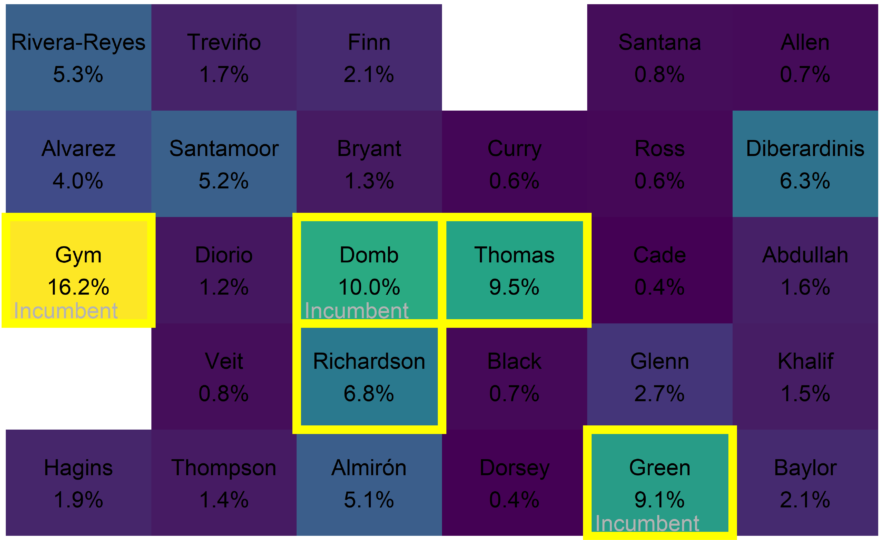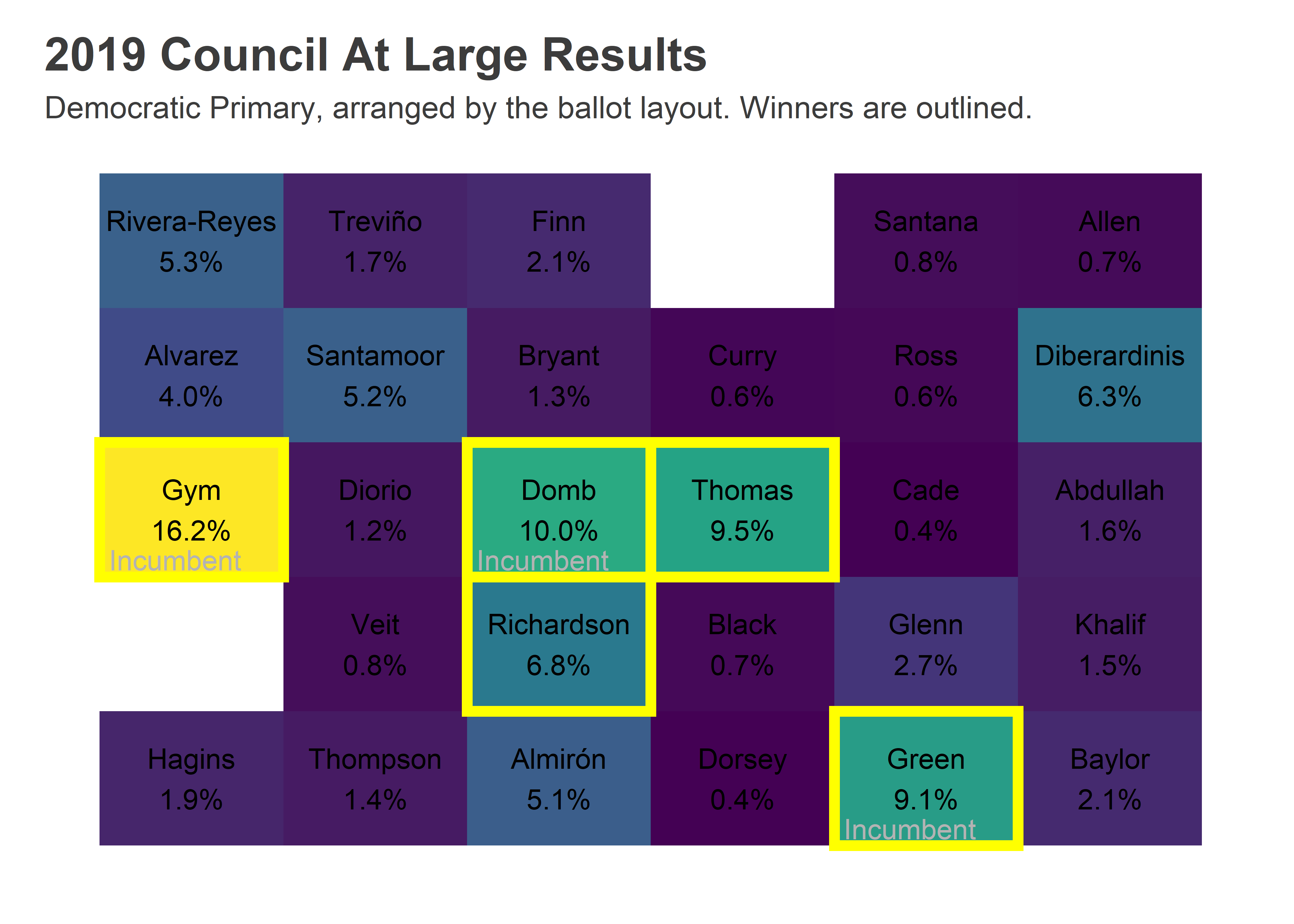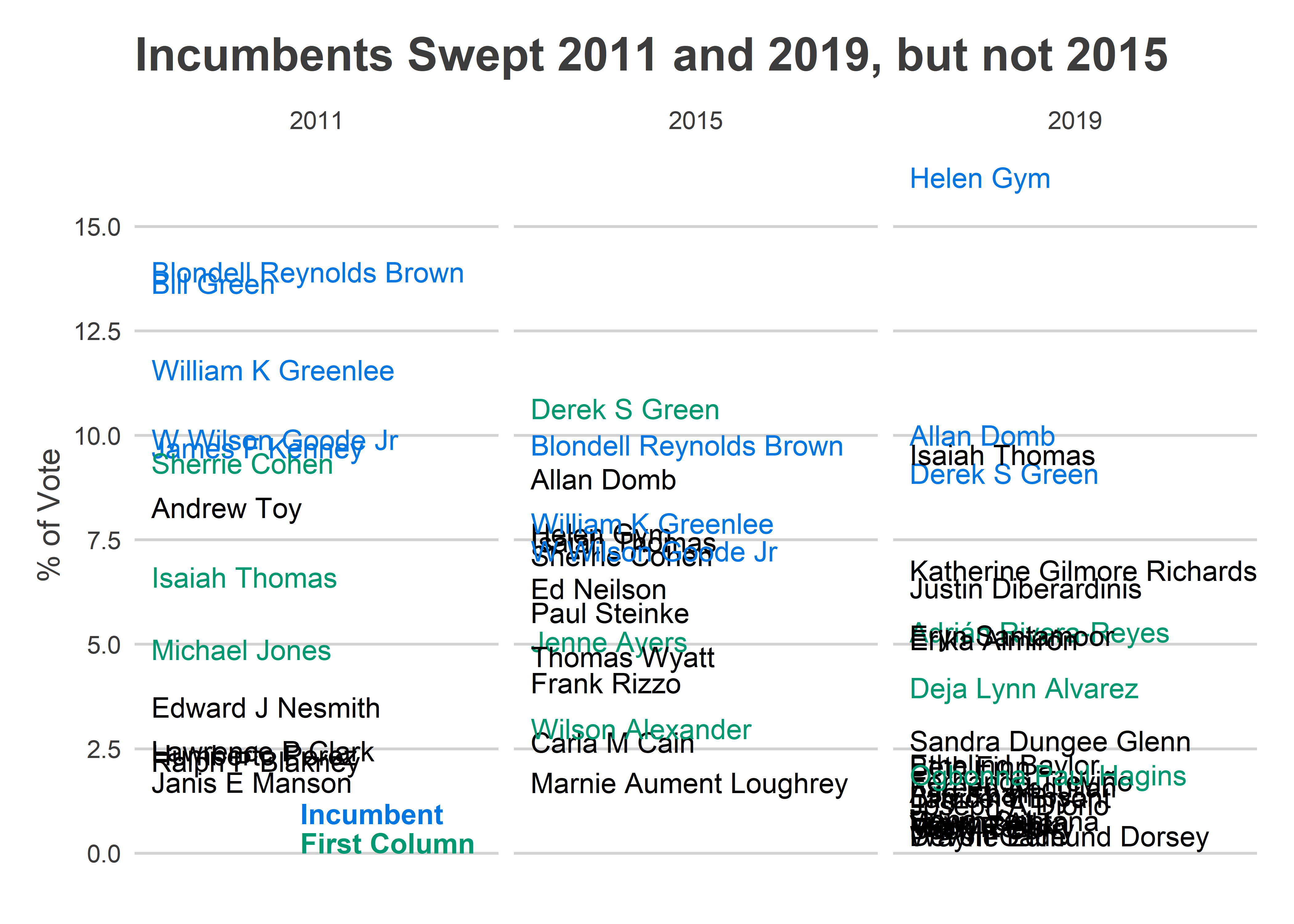Jonathan Tannen, Sixty Six Wards
Seth Bluestein, Philadelphia City Commissioner
Today, Sixty Six Wards is partnering with Philadelphia City Commissioner Seth Bluestein to look at individual voter patterns in the 2023 Democratic Primary.
The 2023 Democratic Primary saw mayoral candidates running in distinct lanes (Sixty Six Wards’ recap, preview). Parker won handily–in retrospect–as Rhynhart and Gym came in distant second and third. In Council, all of the winners were endorsed by the Democratic City Committee, with Santamoor, McIllmurray and Almirón–in 6th, 7th, and 8th–also apparently splitting various non-machine coalitions.
In February, Sixty-Six Wards teamed up with Commissioner Bluestein to look beyond division-aggregated data at individual voter level patterns for correlations and diversity within divisions. We’re doing it again.
The Commissioner’s office has generated that dataset with anonymized, aggregated counts of candidate combinations at the Division level by vote mode–election day, mail-in, provisional–for the 2023 primary.
Rather than a gigantic piece like last time, we will provide a series of short pieces with interesting insights from the data.
How did Mayoral supporters vote for Council?
Today, we examine how each mayoral candidate’s supporters voted for council. Among Divisions, there were strong correlations between Parker and Thomas performance, or Gym and Landau. Some of that may be ecological: supporters tend to live in the same places, but might not be the same people. Just how strong is the voter-level trend?
View code
library(dplyr)
library(ggplot2)
library(tidyr)
pairs <- readr::read_csv(
"../../data/raw_election_data/pairs_new.csv",
locale = readr::locale(encoding = "Latin1")
)
pairs_backup <- pairs
# pairs <- pairs_backup
toplines <- readr::read_csv(
"../../data/raw_election_data/primary_2023_combinations_toplines.csv",
locale = readr::locale(encoding = "Latin1")
)
voters <- readr::read_csv(
"../../data/raw_election_data/primary_2023_combinations_voters.csv"
)
histogram <- readr::read_csv(
"../../data/raw_election_data/primary_2023_combinations_histogram.csv",
locale = readr::locale(encoding = "Latin1")
)
toplines$office_candidate <- factor(toplines$office_candidate)
levels_df <- data.frame(
office_candidate=levels(toplines$office_candidate)
) |>
separate(office_candidate, into=c("office_orig", "candidate_orig"), sep="::", remove=FALSE) |>
mutate(
office_orig = stringr::str_trim(office_orig),
office = stringi::stri_trans_totitle(office_orig),
office = gsub("(Dem|Rep)$", "(\\1)", office),
candidate_orig = stringr::str_trim(candidate_orig),
candidate = gsub("\\s*(DEM|REP) \\([0-9]+\\)$", "", candidate_orig),
candidate = stringi::stri_trans_totitle(stringr::str_trim(candidate)),
candidate = gsub("\\bMc([a-z])", "Mc\\U\\1", candidate, perl=TRUE),
candidate = gsub("\\b([Ii]+)\\b", "\\U\\1", candidate, perl=TRUE),
)
pairs <- pairs |> filter(candidate.x != "overvote")
pairs <- pairs |> filter(candidate.y != "overvote")
pairs$office.x <- factor(pairs$office.x)
pairs$office.y <- factor(pairs$office.y)
pairs$candidate.x <- factor(pairs$candidate.x)
pairs$candidate.y <- factor(pairs$candidate.y)
levels(pairs$office.x) <- levels_df$office[match(levels(pairs$office.x), levels_df$office_orig)]
levels(pairs$office.y) <- levels_df$office[match(levels(pairs$office.y), levels_df$office_orig)]
levels(pairs$candidate.x) <- levels_df$candidate[match(levels(pairs$candidate.x), levels_df$candidate_orig)]
levels(pairs$candidate.y) <- levels_df$candidate[match(levels(pairs$candidate.y), levels_df$candidate_orig)]
testthat::expect_false(any(is.na(pairs$office.x)))
testthat::expect_false(any(is.na(pairs$office.y)))
testthat::expect_false(any(is.na(pairs$candidate.x)))
testthat::expect_false(any(is.na(pairs$candidate.y)))
histogram$office_candidate <- factor(histogram$office_candidate, levels=levels(toplines$office_candidate))
histogram$office <- levels_df$office[histogram$office_candidate]
histogram$candidate <- levels_df$candidate[histogram$office_candidate]
toplines$office <- levels_df$office[toplines$office_candidate]
toplines$candidate <- levels_df$candidate[toplines$office_candidate]Council Results by Mayor
View code
mayor_council <- pairs |>
filter(
office.y == "Mayor (Dem)",
office.x == "Council At-Large (Dem)"
) |>
rename(mayor = candidate.y, council=candidate.x) |>
group_by(mayor, council, Type) |>
summarise(counts = sum(n), .groups="drop")
# Add candidate, Type pairs that are missing
mayor_council <- expand.grid(
mayor=unique(mayor_council$mayor),
Type=unique(mayor_council$Type),
council=unique(mayor_council$council)
) |>
left_join(mayor_council) |>
mutate(counts = replace_na(counts, 0)) |>
left_join(
toplines |>
filter(office == "Mayor (Dem)") |>
group_by(candidate, Type) |>
summarise(topline_votes=sum(votes), .groups="drop"),
by=c("mayor" = "candidate", "Type"="Type")
) |>
mutate(pvote = counts / topline_votes)
get_order <- function(office){
toplines |>
filter(office == !!office) |>
group_by(candidate) |>
summarise(votes = sum(votes), .groups="drop") |>
arrange(desc(votes)) |>
with(candidate)
}
council_order <- get_order("Council At-Large (Dem)")
mayor_order <- get_order("Mayor (Dem)")
mayor_council <- mayor_council |>
mutate(
council = factor(council, levels=council_order),
mayor = factor(mayor, levels=mayor_order)
)
ggplot(
mayor_council |>
group_by(mayor, council) |>
summarise(topline_votes=sum(topline_votes), counts=sum(counts)),
aes(x=council, y=100*counts/topline_votes)
) +
geom_bar(stat="identity") +
facet_wrap(~mayor) +
theme_minimal() %+replace%
theme(axis.text.x = element_text(angle=90, vjust=0.5, hjust=1, size=5)) +
labs(
title="Votes for Council At-Large by Mayoral Vote (Dem)",
x=NULL,
y="Percent of Mayoral voters who cast\nvote for Council candidate"
) Among Parker voters, the five eventual topline winners were on top. But the order was starkly different: third-place Rue Landau finished a distant fifth among this group. Conversely, Landau was the highest vote-getter among Gym voters, and among Rhynhart voters was on par with Thomas and Gilmore-Richardson. There are a few other noticeable peaks in the plot above: Santamoor and Itzkowitz received 36% and 25% of votes from Rhynhart voters, and McIllmurray and Almirón whopping 48% and 46% from Gym voters.
Amusingly, voters who wrote in choices for Mayor were vastly more likely to write in for council, too.
Those patterns didn’t change across vote mode, with Election Day voters and Mail-In voters showing similar preferences (the plots below show only the top four mayoral candidates, for sanity).
View code
ggplot(
mayor_council |>
filter(mayor %in% c("Cherelle L Parker", "Rebecca Rhynhart", "Helen Gym", "Allan Domb")),
aes(x=council, y=100*counts/topline_votes)
) +
geom_bar(stat="identity") +
facet_grid(Type~mayor) +
theme_minimal() %+replace%
theme(axis.text.x = element_text(angle=90, vjust=0.5, hjust=1, size=5)) +
labs(
title="Votes for Council At-Large by Mayoral Vote and Vote Type",
x=NULL,
y="Percent of Mayoral voters who cast\nvote for Council candidate"
) Notice that the average heights of the bars are different between facets; some mayoral candidates’ supporters cast more votes for Council. The heights of the bars would sum to 500 if every voter used all five votes, but only 400 if they used on average four, 300 if three, etc.
View code
mayor_council |>
group_by(mayor, Type, topline_votes) |>
summarise(counts = sum(counts), .groups="drop") |>
mutate(votes_per_voter = counts/topline_votes) |>
ggplot(
aes(x=mayor, y=votes_per_voter)
) +
geom_bar(stat="identity") +
facet_grid(Type~.) +
theme_minimal() %+replace%
theme(axis.text.x = element_text(angle=60, vjust=1, hjust=1)) +
labs(
title="Council At-Large votes per voter, by Mayoral choice",
x=NULL,
y="Average number of votes cast\nfor Council At-Large"
)Among Election Day voters, Gym and Rhynhart supporters cast 3.4 and 3.3 votes for Council At-Large, respectively. Parker supporters cast 2.7, and the rest of voters about 2.5. That difference vanished among Mail-In voters: all candidates’ supporters cast between 3.6 and 4.1 At-Large votes. An obvious explanation is that mail-in voters have time to look up down-ballot candidates with the ballot in hand that Election Day voters do not.
Suppose we recreated the above plot at the Division level: categorize Divisions by which mayoral candidate won, and calculate each council candidate’s percent (we’ll use total votes for Mayor as the denominator). The patterns are reasonably similar to the person-level results.
View code
div_mayor <- toplines |> filter(office == "Mayor (Dem)") |>
group_by(Division, candidate) |>
summarise(votes = sum(votes)) |>
group_by(Division) |>
summarise(
winner = candidate[which.max(votes)],
pvote = votes[which.max(votes)] / sum(votes),
mayoral_votes = sum(votes)
) |>
mutate(mayor = factor(winner, levels=mayor_order))
div_council <- toplines |> filter(office == "Council At-Large (Dem)") |>
group_by(Division, candidate) |>
summarise(votes = sum(votes)) |>
mutate(council = factor(candidate, levels=council_order))
div_council |>
left_join(div_mayor, by="Division") |>
group_by(mayor, council) |>
summarise(
votes = sum(votes),
mayoral_votes = sum(mayoral_votes)
) |>
ggplot(
aes(x=council, y=100*votes / mayoral_votes)
) +
geom_bar(stat="identity") +
facet_wrap(~mayor) +
theme_minimal() %+replace%
theme(axis.text.x = element_text(angle=90, vjust=0.5, hjust=1, size=5)) +
labs(
title="Votes for Council At-Large by Division's Mayoral Winner",
x=NULL,
y="Percent (Votes / Total votes for office of Mayor)"
) There are some interesting, small differences between the plots: Rhynhart Divisions supported McIllmurray over Harrity by 3.2pp, but Rhynhart voters supported Harrity over McIllmurray by 2pp. This is due to ecological correlations: Rhynhart voters live disproportionately in Divisions where the other voters were more likely to support McIllmurray (presumably Gym voters). Similarly, Santamoor beat Harrity by 3.9pp in Gym Divisions, but only by 0.6pp among Gym voters.
Regression Analysis
A form of ecological effects could permeate even the voter-level results above. Maybe Rhynhart voters came from Divisions more likely to support Santamoor, but within each Division they were just like the others. We can solve this by fitting a regression, using Division fixed effects. This allows us to say, for example, that within a given Division, Cherelle Parker supporters were on average 3.2 percentage points more likely to support Jim Harrity, and less likely to support Amanda McIllmurray and Rue Landau (8.8 and 7.9pp, respectively).
View code
mayor_council_div <- toplines |>
filter(office == "Mayor (Dem)") |>
rename(voters=votes, mayor=candidate) |>
select(Type, Division, mayor, voters) |>
# Need this cross join in case there are zero votes for a council candidate.
cross_join(
data.frame(council=unique(mayor_council$council))
) |>
left_join(
pairs |>
filter(
office.y == "Mayor (Dem)",
office.x == "Council At-Large (Dem)"
) |>
rename(mayor = candidate.y, council=candidate.x, votes = n) |>
select(mayor, council, Type, Division, votes),
by=c("mayor", "council", "Type", "Division")
) |>
mutate(votes=replace_na(votes, 0)) |>
group_by(Division, mayor, council) |>
summarise(
voters=sum(voters),
votes=sum(votes)
)
RERUN <- FALSE
library(purrr)
if(RERUN){
df_cand <- mayor_council_div |>
ungroup() |>
filter(council != "Write-In") |>
# filter(council == !!council_candidate) |>
cross_join(data.frame(vote_for=c(0,1))) |>
mutate(votes = ifelse(vote_for==1, votes, voters-votes))
fits <- list()
for(council in unique(df_cand$council)){
print(council)
if(!council %in% names(fits)){
fits[[council]] <- lm(
vote_for ~ Division + mayor,
w=votes,
data=df_cand |> filter(council==!!council)
)
}
}
coefs_full <- lapply(fits, broom::tidy) |> bind_rows(.id="council")
saveRDS(coefs_full, file="coefs_full.RDS")
} else {
coefs_full <- readRDS("coefs_full.RDS")
}
mayor_coef <- coefs_full |>
filter(substr(term, 1,5) == 'mayor') |>
mutate(mayor = gsub("^mayor", "", term)) |>
select(council, mayor, estimate, std.error) |>
bind_rows(
data.frame(
council = council_order,
mayor = "Allan Domb", # Reference mayor
estimate = 0,
std.error = NA
)
) |>
left_join(
toplines |> filter(office == "Mayor (Dem)") |>
group_by(candidate) |>
summarise(total_votes = sum(votes)),
by=c("mayor"="candidate")
) |>
group_by(council) |>
mutate(weighted_coef = estimate - weighted.mean(estimate, w=total_votes))|>
mutate(
council = factor(council, levels=council_order),
mayor = factor(mayor, levels=mayor_order)
)
ggplot(
mayor_coef,
aes(x=council, y=weighted_coef)
) +
geom_bar(stat='identity') +
facet_wrap(~mayor) +
theme_minimal() %+replace%
theme(axis.text.x = element_text(angle=90, vjust=0.5, hjust=1, size=5)) +
labs(
title="Mayoral supporters' relative vote for council",
subtitle="Coefficient of mayoral support on council votes, controlling for Division fixed effects",
x=NULL,
y="Coefficient of Mayoral Support on Council Vote"
)Within a Division, Gym supporters were vastly more likely to support Thomas, Gilmore-Richardson, Landua, McIllmurray, and Almirón, and Rhynhart supporters more likely to support Santamoor, Itzkowitz, and then Gilmore-Richardson, Landau, and Ahmad.
Parker voters were relatively similar to their broader Divisions, but less likely to support Landau, McIllmurray, and Almirón.
Supporters of all mayoral candidates from Domb on were much less likely to support the top four council candidates–Thomas, Gilmore Richardson, Landau, and Ahmad–than supporters of the top three mayoral candidates.


